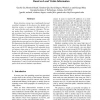89 search results - page 4 / 18 » Stochastic Modeling of Worm Propagation in Trusted Networks |
ITIIS
2010
13 years 9 months ago
2010
There is a well-defined propagation model, named the random constant spread (RCS) model, which explains worms that spread their clones with a random scanning strategy. This model ...
ACSAC
2004
IEEE
14 years 2 months ago
2004
IEEE
Worm detection systems have traditionally focused on global strategies. In the absence of a global worm detection system, we examine the effectiveness of local worm detection and ...
INFOCOM
2003
IEEE
14 years 4 months ago
2003
IEEE
— It has been clear since 1988 that self-propagating code can quickly spread across a network by exploiting homogeneous security vulnerabilities. However, the last few years have...
WORM
2004
14 years 4 days ago
2004
A major challenge when attempting to analyze and model large-scale Internet phenomena such as the dynamics of global worm propagation is finding ate abstractions that allow us to ...
IEEEIAS
2009
IEEE
14 years 5 months ago
2009
IEEE
A computer worm is an autonomous malicious, selfreplicating and propagating piece of code that is able to spread fast in computer networks, exploiting the vulnerabilities it disco...

